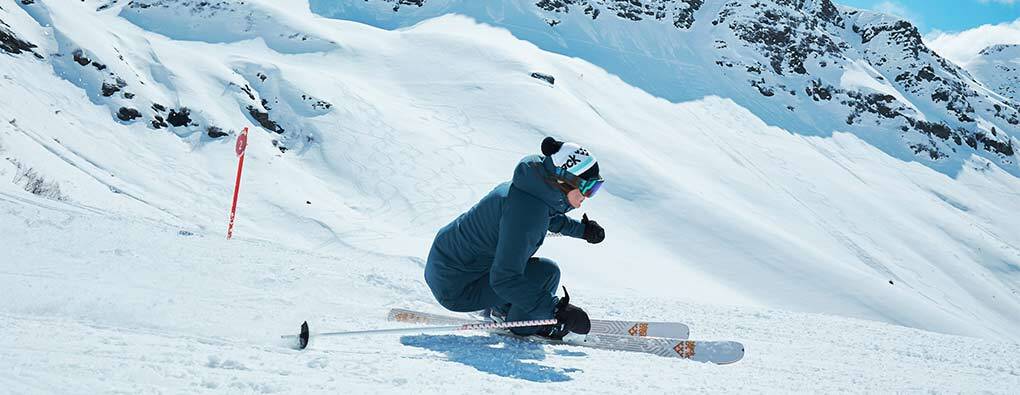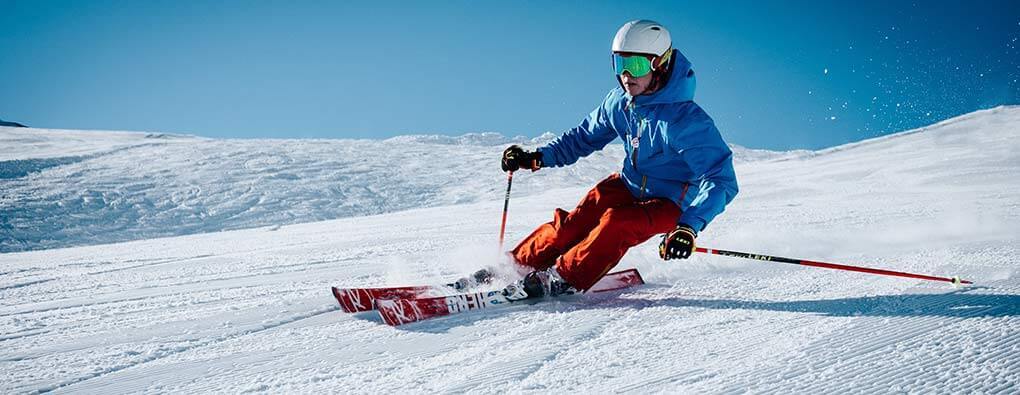Buying Skis for Beginners
If you are a beginner skier and ready to purchase your first pair of skis then here is a guide to lead you in the right direction. To keep things simple, we will help you identify what type of skis would be best for you, what length to choose, and some additional information about ski width.
Before making the final decision it is important to search for skis appropriate for your skill level in the beginner category. This will lead you to skis that are designed to be more forgiving and easy to control. Beginner skis will also include bindings that are size adjustable and simple to use.
Buying your own pair of skis allows you to become familiar with how they feel and respond to you, which can be one of the main advantages over renting them.
PISTE SKIS - The best carving skis on groomed pistes
As the name suggests, the skis are designed to be used on-piste. Beginner skiers spend all of their time on-piste where they can learn the basics, so Piste skis are an ideal choice. Even once you have mastered the easy slopes, Piste skis can take you to the next level. The skis are generally narrow in width which increases their ability to grip the snow.
ALL MOUNTAIN SKIS - The Best All-round Skis

These versatile skis are made for a range of conditions. They perform excellently on the piste but can handle some off-piste skiing as well. If you have skied a few times before and would like skis that aren’t just for on-piste skiing then All Mountain skis might be the right option for you. They are designed with a narrow to average width to strike the balance of gripping firm snow on-piste and handling soft and bumpy snow off-piste.
Shop for your new All Mountain Skis
SPECIALIZED SKIS
You can also find other specialized skills such as Park, Racing, Freeride, and Touring skis. They are normally reserved for more experienced skiers. If that's something that interests you, we recommend reading our Buying Skis for Experienced Skiers where we go into more detail.
Choose the right Ski Length
When choosing your ski length you will need to know your height and skill level. As a beginner, you should select a ski that is close to the height of your nose. Each ski model is made in a variety of lengths so you will have to choose one that is nearest to your recommended length. (3 cm longer or shorter than this is not a problem).
The size chart indicates that the less skiing experience you have, the shorter the skis should be. This is because shorter skis are easier to control which is important while learning.
Your weight is a secondary factor that can guide you to the right size. If your weight is considerably lighter or heavier than the average person, you can also consider choosing shorter or longer skis. Longer skis for heavier people and shorter for lighter people.
The picture illustrates the ski length for a beginner skier
| All Mountain/Piste Skis | |
| First-timer | your height -20 cm |
| Beginner | your height -15 cm |
| Intermediate | your height -10 cm |
| Advanced | your height -5 cm |
| Expert | your height |
Ski Width
The width of the skis can tell you how well they will perform on different types of terrain. The general rule is that narrow skis are for hard snow and wide skis are for soft snow. Ski width is described in 3 numbers and they refer to the tip - waist - tail measurements.
The waist width is the one that reveals the most detail and is always the middle number. Example: 132/78/113
This measurement is displayed on our website under the specification of each of our skis.
Skis waist widths between 70 to 82mm are perfect if you are going to be spending most of your time on the piste as they are designed to grip the firm snow. That is why they are the perfect choice for beginner skiers.
Other Ski Equipment
Ski Boots
Ski boots are arguably the most important piece of equipment you should buy when going on a ski holiday. You can find all you need to know in the Buying Ski Boots Guide but here is some useful information to get you started.
Ski boot sizes are measured in centimeters and it refers to the full length of the foot from the heel to toe. You can find out your exact size by measuring your feet with a tape measurer or ruler. As well as size, every pair of boots has a flex value which describes how flexible the outer shell is. For comfort reasons, a beginner should look for boots that they can easily flex in (Flex 60-90). You can find your recommended boot flex and further details in the Boot Flex Guide.
Tip: Are your ski boots uncomfortable? Make sure that your ski pants are not tucked inside your boots. The only thing that should be in your boot is your foot and tall skis sock. Good quality ski socks can prevent blisters and pain or even cold toes.
Ski Poles
Ski poles help you to move forward on flat ground and provide better balance. At the lower end of the pole, usually, there is a round plastic disc, which helps to prevent the ski pole from sinking too deeply into the snow. The Ski Pole Length Size Chart will help you to find out the right length of the poles based on your height.
Helmets
Compared to 20 years ago the majority of skiers nowadays do wear a helmet whether they are beginners or experts. It can keep you warm but most importantly it can save your life.
Ski helmets are specifically made to last and protect you from multiple impacts. Whereas other helmets such as skate or bike helmets are not designed the same way and therefore not a good alternative.
You may also want to read more about How to wear your helmet or Lifespan of helmets.
Goggles
Goggles will definitely make your ski vacation more enjoyable. Not only do they protect your eyes from bright sunlight, harsh wind, or snow but also improve your vision. Read more about goggles in our guide The ultimate ski and snowboard goggles guide.



